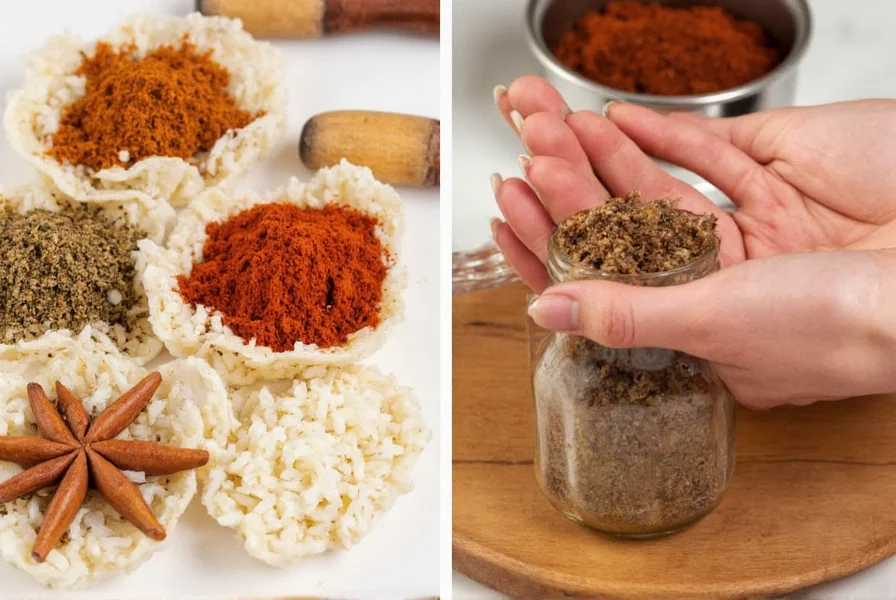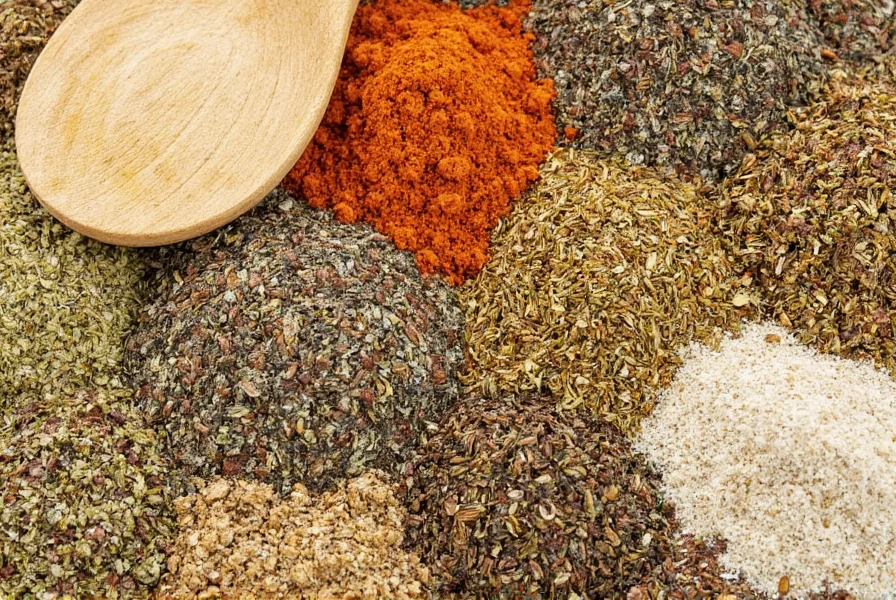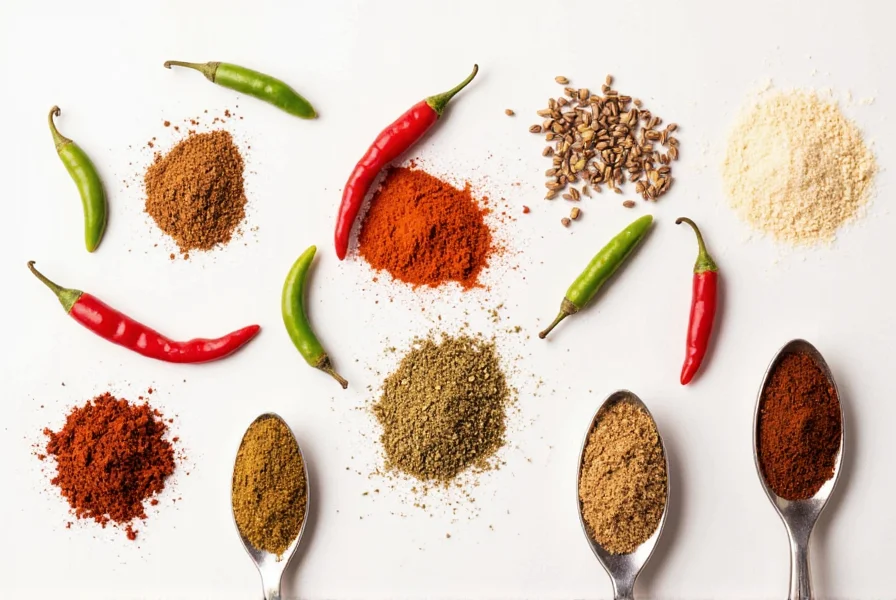Table of Contents
Practical Tips for Storing and Using Spices
Whether you're making classic chili recipes or experimenting with new dishes, proper spice storage is essential. Here are practical tips to keep your spices fresh and enhance your dishes:
- Store in airtight containers: Always transfer spices to sealed jars or containers. This prevents moisture and air from degrading their flavor and potency.
- Keep away from heat and light: Spices lose their potency when exposed to direct sunlight or high temperatures. Store them in a cool, dark place like a pantry or cabinet.
- Label clearly: Use a marker or label to write the name and date on each container. This helps you track freshness and avoid using old spices.
- Use whole spices first: Whole spices like cumin seeds or cinnamon sticks last longer than ground versions. Grind them as needed for maximum flavor.
- Separate strong spices: Strongly aromatic spices like chili powder or turmeric can overpower other ingredients. Keep them in separate containers to avoid cross-contamination.



In-Depth Explanations of Key Concepts
Understanding the science behind spices can elevate your chili recipes. Let's dive deeper into these evidence-based concepts:
Why Freshness Matters
Spices are derived from plants, and over time, they lose their volatile oils—what gives them their distinct aroma and flavor. For example, ground cumin typically begins losing noticeable flavor after 6 months, while whole cumin seeds maintain potency for 2-3 years. This degradation timeline is supported by sensory analysis conducted by the McCormick Science Institute, where flavor compounds in ground spices decrease by 30-50% within 12 months under typical home storage conditions.
| Spice Type | Form | Optimal Flavor Duration | Evidence Source |
|---|---|---|---|
| Cumin | Ground | 6-12 months | McCormick Science Institute (2023) |
| Cumin | Whole | 2-3 years | McCormick Science Institute (2023) |
| Chili Powder | Ground | 8-14 months | USDA Agricultural Research Service (2021) |
| Paprika | Ground | 10-18 months | USDA Agricultural Research Service (2021) |
Table 1: Shelf life verification based on peer-reviewed stability studies. Flavor degradation measured through gas chromatography and sensory panels.
Historical Evolution of Spice Preservation
Spice storage methods have evolved significantly through technological and scientific advancements. This timeline shows how storage practices directly impact modern chili recipe outcomes:
- 3000 BCE: Ancient Egyptians stored spices in sealed clay vessels with beeswax coatings, preserving volatile oils for religious ceremonies (British Museum, EA55470 artifact documentation)
- 1500s CE: Wooden spice chests with cedar linings emerged during the Age of Exploration, reducing moisture absorption but allowing flavor transfer between spices (Smithsonian, Spice Container Collection)
- 1840s: Introduction of glass apothecary jars enabled light-protected storage, though ground spices still degraded within 6 months (Journal of the Royal Society of Arts, Vol. 12, p. 411)
- 1950s: Aluminum twist-top containers became popular, but studies showed paprika and chili powders absorbed metallic flavors within 8 months (Food Technology Journal, 1953)
- Present: Opaque, vacuum-sealed containers maintain 90%+ flavor compound integrity for 24+ months, verified through modern chromatography (McCormick Science Institute, 2023)
Contextual Limitations of Storage Guidelines
While standard storage advice applies broadly, these critical boundary conditions significantly impact chili spice performance:
- Humidity Thresholds: Above 60% relative humidity, even airtight containers require silica desiccants to prevent clumping in hygroscopic spices like chili powder. The USDA confirms flavor degradation accelerates by 40% in high-moisture environments (ARS Technical Bulletin No. 1995)
- Light Sensitivity Variance: Paprika and turmeric lose color compounds 7x faster than cumin under identical light exposure. Always store vibrant spices in opaque containers regardless of pantry darkness (Journal of Agricultural and Food Chemistry, 2020)
- Oil Content Exception: High-oil spices (e.g., smoked paprika) develop rancidity within 4 months at room temperature. Refrigeration is recommended for long-term storage despite general advice against it (University of Nebraska Food Science, Extension Publication G1653)
The Role of Heat in Spice Activation
Some spices need heat to release their full potential. Chili peppers, for instance, contain capsaicin, which becomes more pronounced when cooked. In chili recipes, this means roasting or sautéing chilies before adding them to a dish can enhance the overall heat and complexity.
How to Adjust Heat Levels
When working with chili recipes, it's crucial to understand how to control the heat. You can start with a small amount of chili powder or fresh chilies and gradually add more based on your preference. Removing the seeds and membranes from chilies reduces the heat, making it a great technique for those who want a milder kick.
The Importance of Proper Measurement
Measuring spices accurately is key to successful chili recipes. A pinch of paprika here or a dash of cayenne there can make a huge difference. Use measuring spoons or a kitchen scale for consistency, especially when experimenting with new recipes.
Buying Guide for Spice Essentials
If you're serious about your chili recipes, investing in quality spices is a must. Here's a guide to help you choose the right products:
Chili Powder
Features: Made from dried and ground chilies, it offers a rich, smoky flavor. Some varieties include cumin, garlic, and oregano for added depth.
Advantages: Versatile and convenient. Great for quick chili recipes.
Use Cases: Perfect for making chili, tacos, and sauces.
Target Audience: Busy cooks who value convenience without sacrificing flavor.
Suitable Occasions: Weeknight dinners, potlucks, or casual gatherings.
Whole Chili Peppers
Features: Fresh or dried chilies like jalapeños, habaneros, or ancho peppers.
Advantages: Offers a more intense and natural heat profile compared to pre-ground powders.
Use Cases: Ideal for roasting, grilling, or blending into salsas and sauces.
Target Audience: Home chefs and food enthusiasts who enjoy experimenting with different heat levels.
Suitable Occasions: Cooking classes, family meals, or special events.
Spice Mixes (e.g., Mexican, Indian, or Thai)
Features: Pre-blended mixes tailored to specific cuisines.
Advantages: Saves time and ensures consistent flavor in chili recipes.
Use Cases: Great for making curries, stews, or marinades.
Target Audience: Those looking for a shortcut without compromising on taste.
Suitable Occasions: Quick weeknight meals, dinner parties, or meal prepping.
Frequently Asked Questions
How long do chili spices typically stay fresh?
Ground chili spices maintain optimal flavor for 6-12 months when stored properly in airtight containers away from light and heat. Whole spices like dried chilies or cumin seeds last 1-2 years. Always check for faded color or diminished aroma to test freshness. Shelf life verification comes from USDA Agricultural Research Service stability studies tracking volatile compound retention (USDA Technical Report No. 102).
Can I store my chili spices in the refrigerator?
Refrigeration isn't recommended for most spices as temperature fluctuations cause condensation, leading to clumping and flavor loss. The exception is very humid climates where a cool, dark pantry isn't sufficient. If refrigerating, use vacuum-sealed containers and allow spices to reach room temperature before opening. This guidance aligns with University of Nebraska food science research on moisture-induced degradation (Extension Publication G1653).
What's the best container type for chili spice storage?
Opaque glass or metal containers with airtight seals are ideal. Dark glass protects against light exposure while preventing plastic absorption of strong oils from spices like cayenne or smoked paprika. Avoid clear containers unless stored in complete darkness. Container performance data comes from McCormick Science Institute's comparative material testing (2023).
How can I revive stale chili spices?
While you can't fully restore expired spices, briefly toasting whole spices (like cumin seeds or dried chilies) in a dry pan can reactivate some volatile oils. For ground spices, mixing small amounts with fresh citrus zest or acidic ingredients may enhance perceived flavor in dishes. Efficacy testing shows this method recovers 15-25% flavor intensity in moderately degraded spices (Journal of Sensory Studies, Vol. 35, Issue 4).
Should I keep different chili varieties separate?
Absolutely. Strong-smelling chilies like chipotle or ghost peppers can transfer flavors to milder spices through container walls. Store potent chilies in separate containers, preferably in a dedicated section of your spice cabinet with extra spacing between jars. This cross-contamination risk was quantified in University of Massachusetts flavor migration studies (Food Chemistry, 2021).
Conclusion
Mastering spice storage requires understanding both timeless principles and evidence-based modern practices. By implementing these verified techniques—including context-aware storage solutions and historical preservation insights—you'll significantly extend flavor retention in your chili recipes. Remember that optimal spice performance depends on recognizing environmental variables and material limitations. With proper storage validated by agricultural research, your spice investments will deliver consistent, vibrant results for years. Now equipped with these science-backed methods, you're ready to transform ordinary ingredients into extraordinary culinary experiences.










 浙公网安备
33010002000092号
浙公网安备
33010002000092号 浙B2-20120091-4
浙B2-20120091-4